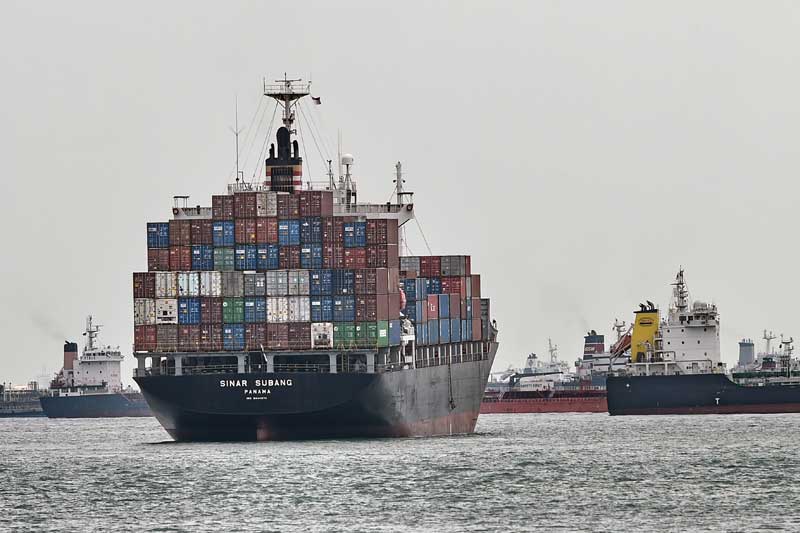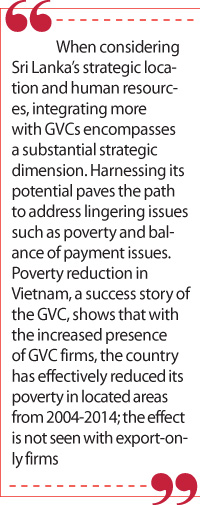Wednesday Dec 24, 2025
Wednesday Dec 24, 2025
Wednesday, 1 September 2021 00:02 - - {{hitsCtrl.values.hits}}

 One thing that does not strike your mind when spending leisure time with your smartphone, perhaps even while lounging on the couch and sipping a drink, is that this little electronic device could be a result of a complex production process that runs splendidly smooth across the globe.
One thing that does not strike your mind when spending leisure time with your smartphone, perhaps even while lounging on the couch and sipping a drink, is that this little electronic device could be a result of a complex production process that runs splendidly smooth across the globe.
However, today’s production complexities make it possible to span this production throughout the globe and to a level that the end-user would never even imagine was possible. Suppose we take an iPhone, for example; in this case, the phone builds upon a Californian, USA design and concept. It is, though, assembled in China with hardware components and software made in Germany, Japan, Vietnam, South Korea, UK, the US and elsewhere, so it provides a great example of today’s complex Global Value Chain (GVC) production line1 .
The concept shares global goods production across different international markets and is split up into activities and tasks from different expertise labour pools, and today GVCs encompass nearly 70-80% of total international trade. One country, therefore, does not work solely on manufacturing a finished product from scratch. Instead, multiple countries are links in a big value chain, dependent on inputs (imports) from other countries. These countries then send the product on to the next node (export) once their value addition to the product is made.
As the world is in an era of GVCs, pushing boundaries of the international economies into a new means of an economic model, this article looks at Sri Lanka’s way forward in integrating into this concept by weighing up the impacts from recent events.
How to link with GVCs, and where does Sri Lanka stand?
The most straightforward and traditional way of integrating into GVC is through bilateral trade in intermediate products. According to a classification by WDR (2020), countries across the globe participate in GVCs under different dimensions, namely those who participate in GVCs through commodity exports, manufacturing (limited and advanced) and innovative activities2. Countries like Sri Lanka belong to limited manufacturing countries, where those countries are neither heavy commodity exporters nor countries involved in innovative activities GVCs.
Out of manufacturing countries, limited manufacturing countries change from their advanced manufacturing counterpart based on two main criteria: (i) lower share of manufacturing and business services in total domestic value-added exports (ii) exports in the manufacturing sector contains a lower share of previously imported intermediates from abroad. In limited manufacturing economies, manufacturing and business services are endowed with FDIs, basic technical, management, and language skills. Further, they integrate with GVCs through basic means of agreements and contract enforcement.
In contrast, upper-level advanced manufacturing and innovative countries do not solely depend on FDIs; instead, they themselves have a high-skilled workforce and use advanced technical, research, and managerial skills. These countries integrate with GVCs through deeper trade agreements and intellectual property protection, so the strategy is different from their limited manufacturing countries. Throughout time, countries have also upgraded on this scale as well. From 1990-2015, for example, Asian countries, such as China, India, the Philippines, and Thailand, upgraded from limited manufacturing to its upper level, advanced manufacturing.
 Why are GVCs important to Sri Lanka?
Why are GVCs important to Sri Lanka?
When considering Sri Lanka’s strategic location and human resources, integrating more with GVCs encompasses a substantial strategic dimension. Harnessing its potential paves the path to address lingering issues such as poverty and balance of payment issues. Poverty reduction in Vietnam, a success story of the GVC, shows that with the increased presence of GVC firms, the country has effectively reduced its poverty in located areas from 2004-2014; the effect is not seen with export-only firms2.
In addition, countries better integrated into GVCs, such as Vietnam, substantially improved their current accounts over the past (Vietnam recorded a current account surplus of $ 12.5 billion in 2019 and $ 7.5 billion in 2020, respectively 5% and 2.76% of GDP, Source: Knoema). So, it provides a lasting solution for Sri Lanka’s prolonged battle for external sector issues, including the foreign debt overhang.
Furthermore, such alignment whets the appetite and helps calibrate the country’s skill pool in line with international standards. Compared to non-GVC traditional exports, it provides a complete picture of international standards and how we should design our system to cater to these needs when connected to global standards.
What about the region?
South Asia, the country’s region, has a fundamental disadvantage of less cooperative inter-regional partnerships in GVCs. It seems countries in the region individually are trying to link into the outside region GVC streams.
The Organisation for Economic Co-operation and Development (OECD), highlighted this fact in one of their publications comparing the South Asian region with South-East Asia3. The analysis shows the latter source about 30% of its intermediate inputs required for GVC outputs from the region, whereas the latter only source 7% from their neighbouring partners.
The inexpensive labour force, which South Asian countries mostly use in industries, such as textiles, is one reason that incentivises them to insist on this strategy. However, with this strategy, the region’s future in GVCs is far from secure as the continuous availability of cheap but low-skilled labour is not persistent. China, for example, had reaped this advantage initially; however, now the Asian GVC giant seems to be slowly losing its grip on this edge with the uplifting of the living standards of workers and a leaning towards state-of-the-art strategies to hold its ground.
Additionally, as the most resourceful South Asian nation, India is chasing its missed glory in GVCs and has been recently upgraded to an advanced manufacturing nation, and perhaps it fixes a missing link to connect with the South East/East Asian region. This region has a well-established GVC cluster around China, the most crucial hub of GVCs for many multinational enterprises (MNEs).
Do recent changes shed light on new opportunities?
Recent changes to the GVCs, especially the impact of the COVID-19, are another dimension worth weighing up when designing the landscape for future GVC integration. Although the GVCs’ manoeuvre through the pandemic has been a rollercoaster, the virus’ overall impact on GVCs arguably has raised prospects in some aspects for a country like Sri Lanka.
First, the pandemic highlighted the susceptibilities of the existing GVCs, such as how interruptions to one node of production could delay the whole production process (e.g. this was particularly pronounced in the medical systems supply chains). This situation forced firms to rethink their essential supplies’ robustness and diversify their supply strategically. Being strategically located in the Indian Ocean, the island nation can help facilitate this robustness by seeking increased pledges to improved infrastructure development and striving for solid marine networks with regional actors.
Second, the pandemic initiated a broader discussion focusing on the importance of the interconnectedness of countries and economies with optimal use of global resources focusing on broad-based groups of beneficiaries. Unbundling global production is a possible solution not far from this discussion. It efficiently reaps the maximum benefits out of global resources by channelling the benefits across a larger group of economies. This shift reiterates the importance of GVCs going forward and highlights the importance of inclusiveness of smaller countries, such as Sri Lanka, to play a bigger role in global scale productions and services rather than being overlooked.
The pandemic has also sparked prolonged discussions about enforcing stringent environmental standards across GVCs and shifting to green value chain concepts that reduce environmental effects, and these will no doubt emerge in the future with incentives to players who insist on those commitments. This area involves intense knowledge incentive analyses on environmental hotspots in GVC, pinpointing the most environmentally damaging stages of the product life cycle, and minimises them. For example, in textile manufacturing, the dyeing process may be a hotspot most harmful to the environment due to polluted water and chemicals, resulting in the death of aquatic life, soil degradation, and pollution of drinking water.
Moreover, despite being in the throes of a global pandemic, the increased focus for digitalisation, automation, and innovations in technology fronts are likely to be other advancements in GVCs. While they are also expected to reduce red tape attached to existing GVCs that thwart smoothing out of those processes by reducing trade costs, at the same time, they intend to create new opportunities in GVCs for countries like Sri Lanka.
How should we align from a policy perspective?
This article explored what GVCs are and why it is important to focus more on them, as well as the regional climate for GVCs and recent trends worth discussing relating to the production phenomenon.
Therefore, policies promoting more intermediate GVC product trades within the South Asian region help countries like Sri Lanka stand on the shoulders of big South Asian GVC players like India. Upon thriving, it even could be extended and merged with East/South-East Asian area, which is more developed in GVC trade and centred around China.
Also, as the idea of gaining a competitive edge over low-cost labour is losing its popularity, the country should now insist on recognising new inclinations of GVCs. Its futuristic form, for example, will likely be relying on more robust, knowledge incentive, and environmentally friendly approaches.
Finally, it should not be underestimated that business climate, efficient logistics, the rule of law and political stability are essential factors, as better integrating with GVCs requires attracting FDIs, and move into deeper trade agreements with core players of GVCs. So, it is not a straightforward mission, but it provides more efficient results once it succeeds with internationalised firms and production chains.
Overall, GVCs and their recent dynamics are worth investigating from a Sri Lankan perspective because of their undeniable economic potential and ability to fit the country into a more internationally connected and accepted groove. Following such an assessment, adopting firm GVC-friendly policies immune to the costly back-and-forths that can have depending on who is in the office ensures Sri Lanka’s seamless participation in global trade flows.
References
1 https://www.apple.com/supplier-responsibility/pdf/Apple-Supplier-List.pdf
2 https://openknowledge.worldbank.org/handle/10986/32437
3 https://www.oecd.org/countries/congo/Participation-Developing-Countries-GVCs-Summary-Paper-April-2015.pdf
(The writer, a former Senior Assistant Director of the Central Bank of Sri Lanka, is a PhD candidate attached to Monash University, Australia. He pursued his undergraduate studies in Engineering from the University of Moratuwa and graduate studies in Finance/Economics from the University of California, Berkeley, USA and the University of New Mexico, USA. The writer could be reached via [email protected].)